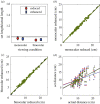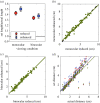Luminance contrast provides metric depth information
- PMID: 36816842
- PMCID: PMC9929495
- DOI: 10.1098/rsos.220567
Luminance contrast provides metric depth information
Abstract
The perception of depth from retinal images depends on information from multiple visual cues. One potential depth cue is the statistical relationship between luminance and distance; darker points in a local region of an image tend to be farther away than brighter points. We establish that this statistical relationship acts as a quantitative cue to depth. We show that luminance variations affect depth in naturalistic scenes containing multiple cues to depth. This occurred when the correlation between variations of luminance and depth was manipulated within an object, but not between objects. This is consistent with the local nature of the statistical relationship in natural scenes. We also showed that perceived depth increases as contrast is increased, but only when the depth signalled by luminance and binocular disparity are consistent. Our results show that the negative correlation between luminance and distance, as found under diffuse lighting, provides a depth cue that is combined with depth from binocular disparity, in a way that is consistent with the simultaneous estimation of surface depth and reflectance variations. Adopting more complex lighting models such as ambient occlusion in computer rendering will thus contribute to the accuracy as well as the aesthetic appearance of three-dimensional graphics.
Keywords: binocular disparity; image statistics; shape from shading; stereopsis; vision.
© 2023 The Authors.
Conflict of interest statement
We declare we have no competing interests.
Figures







References
-
- Cutting JE, Vishton PM. 1995. Perceiving layout and knowing distances: The integration, relative potency, and contextual use of different information about depth. In Perception of Space and Motion, pp. 69-117.
-
- Horn BKP, Brooks MJ. 1989. Shape from Shading. Cambridge, MA: MIT Press.
Associated data
LinkOut - more resources
Full Text Sources

